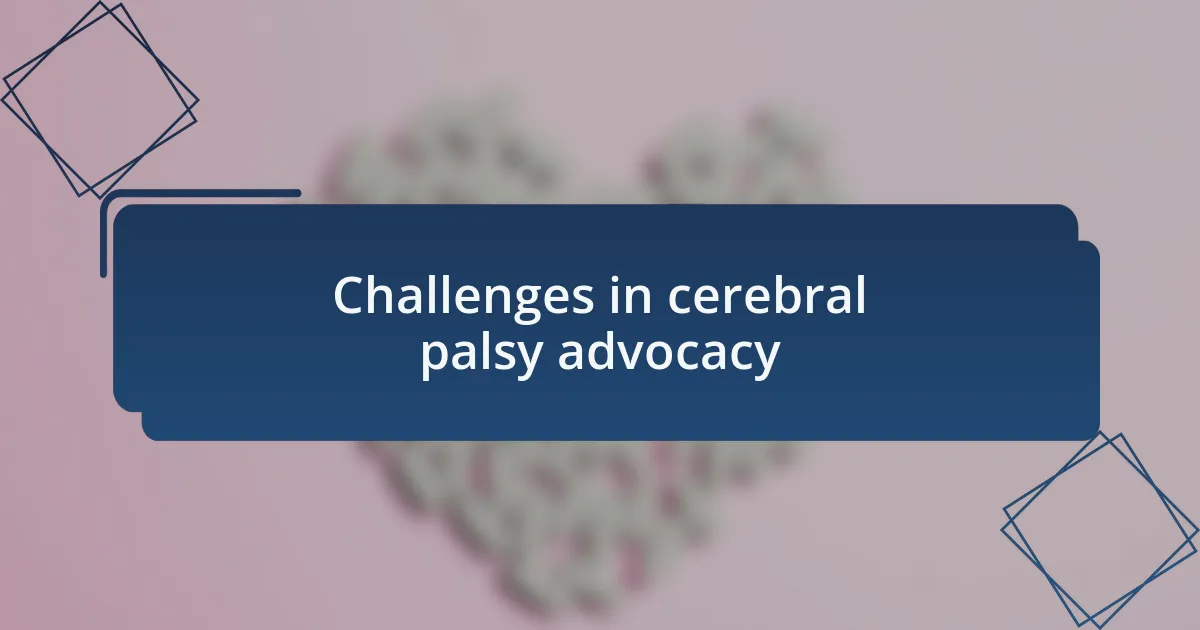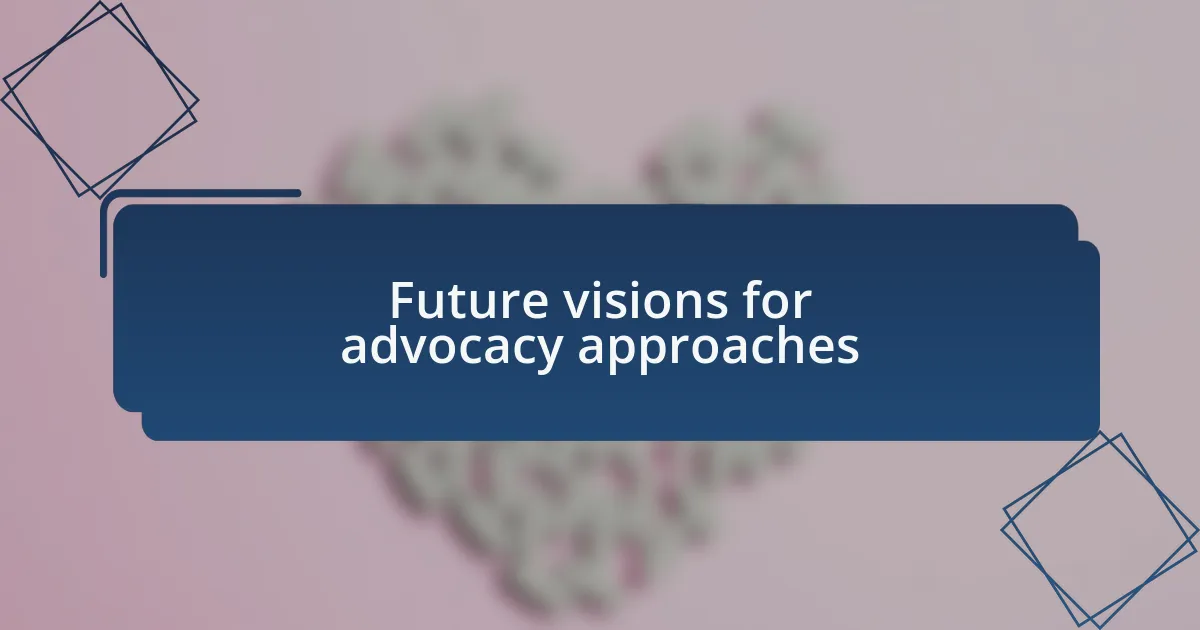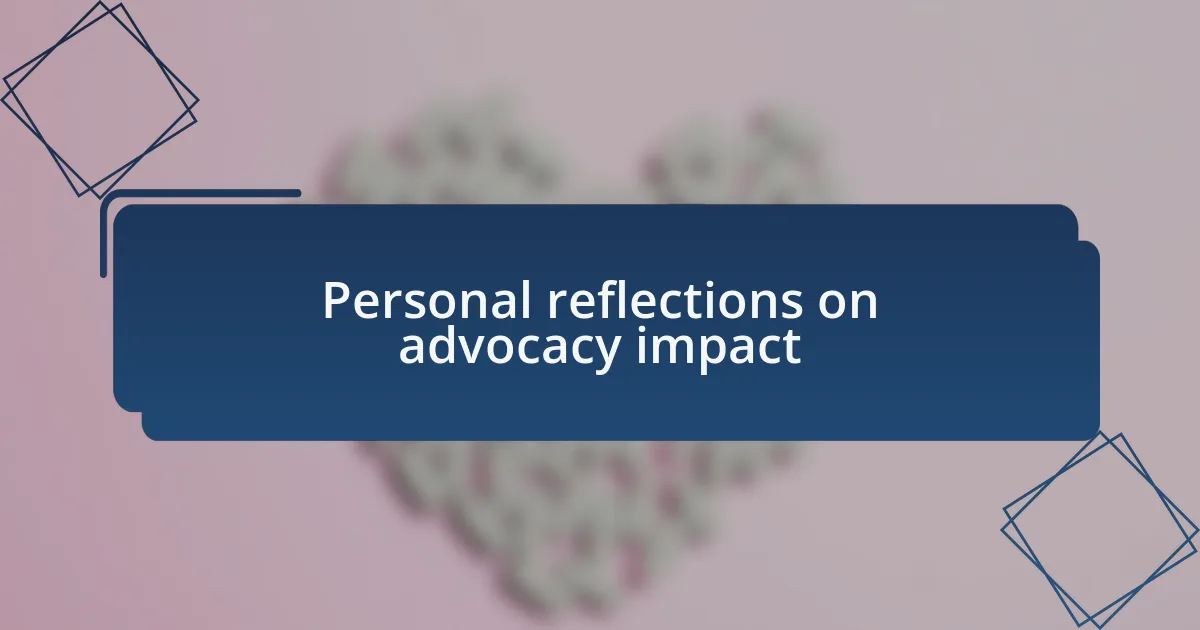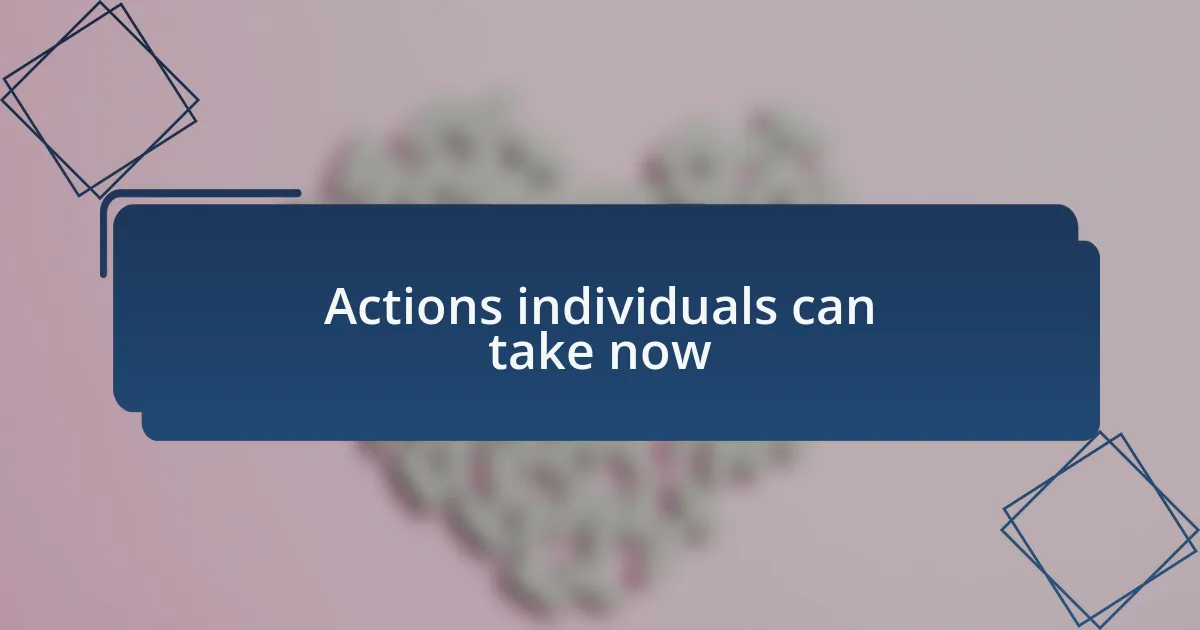Key takeaways:
- Advocacy involves diverse voices, including those of individuals with cerebral palsy, to effectively represent needs and amplify unheard perspectives.
- Challenges in advocacy include financial barriers, misconceptions about cerebral palsy, and the emotional toll on advocates, highlighting the need for resilience and collective strength.
- Future advocacy may leverage technology and social media for grassroots mobilization and community engagement, while education on cerebral palsy in schools could change perceptions from an early age.
- Personal narratives in advocacy can transform struggles into collective strength, emphasizing the emotional weight and motivating potential of shared experiences.

Understanding advocacy in support
Advocacy is more than just a word; it’s a powerful tool that shapes the experiences of individuals with cerebral palsy. I remember attending a local advocacy meeting where parents shared their struggles with accessing necessary therapies for their children. Hearing their stories made me realize how vital it is for advocates not only to represent needs but to amplify voices that often go unheard.
When we talk about advocacy, it’s important to consider who is at the table. Have you ever questioned whose perspectives are included in decision-making? In my experience, effective advocacy requires diverse voices—those from the community, experts, and, more importantly, individuals with cerebral palsy themselves. It’s through these varied lenses that we can gain a fuller understanding of what support truly looks like.
I’ve found that personal connection is what makes advocacy resonate. When advocates share their truths—like the day my friend was able to access a critical service after years of navigating bureaucracy—the emotional weight of those moments underscores the need for persistent, informed advocacy. This shared journey not only fosters hope but also fuels our collective mission to create a more inclusive future.

Challenges in cerebral palsy advocacy
Advocacy for people with cerebral palsy often faces significant hurdles, particularly around funding and resource allocation. I recall a colleague expressing frustration when a promising program was cut due to lack of financial support. This left families scrambling to find alternative services, highlighting how financial barriers can stifle much-needed initiatives. How can we expect advocacy efforts to thrive if they constantly contend with insufficient resources?
Another challenge is the misconception about cerebral palsy itself. Once, during a community event, I overheard someone dismissing the capabilities of individuals with this condition, assuming they couldn’t be active participants in their advocacy. It struck me that these misunderstandings not only undermine the credibility of advocacy efforts but also perpetuate stereotypes that can harm the community’s overall perception. How can we shift these narratives to foster a more inclusive understanding of cerebral palsy?
Lastly, the emotional toll on advocates can be overwhelming. I have often witnessed passionate advocates becoming discouraged, feeling as though their efforts to drive policy change are met with resistance. There are days when it feels like one step forward and two steps back. Yet, within that struggle lies an opportunity for resilience and collective strength. By acknowledging these challenges, can we find new ways to unite and push for progress together?

Future visions for advocacy approaches
The future of advocacy for cerebral palsy is likely to be driven by a more technological approach. I envision a landscape where digital platforms empower voices that have been historically silenced. Imagine virtual town halls where individuals with cerebral palsy can directly interact with policymakers, sharing their experiences in real-time. Isn’t it exciting to think about how accessible technology could foster genuine dialogue and understanding?
As I reflect on these future possibilities, I also think about the importance of community engagement in advocacy. Local organizations can harness social media to amplify their reach and connect families to resources and supportive networks. I’ve seen firsthand how social media campaigns can mobilize communities around specific issues. When a small group made a vibrant online push for inclusive education, the ripple effects were astonishing. Could mobilizing these grassroots movements become a cornerstone of future advocacy strategies?
Moreover, integrating education about cerebral palsy into school curriculums could fundamentally shift perceptions from a young age. I often wonder how different attitudes would be if children learned about diversity and ability early on. Changing the narrative starts with education, and that might just lay the foundation for a more inclusive future. How powerful would it be to see a generation grow up with a more profound understanding of cerebral palsy?

Personal reflections on advocacy impact
When I think about the impact of advocacy, memories of powerful moments come to mind. I once attended a rally where advocates shared their stories, and it felt like the air was charged with shared hope and determination. Listening to those heartfelt testimonies reminded me how vital it is for individuals with cerebral palsy to have their voices heard; it was a gathering that transformed personal struggles into collective strength. Can you imagine what more of such moments could achieve?
Reflecting on my own advocacy efforts, I recall how a small community meeting led to a significant policy change in our local school district. That evening, after sharing our stories, it was evident that emotional connections can spark real change. Advocating for inclusion isn’t just about facts and figures; it’s about weaving personal narratives into the bigger tapestry of change. Isn’t it remarkable how one shared experience can ripple through a community, galvanizing support and prompting action?
The emotional weight of advocacy can be overwhelming yet motivating. I remember feeling a mixture of fear and excitement the first time I spoke publicly about my journey with cerebral palsy. The applause that followed wasn’t just for me; it symbolized the voices of countless others who felt unheard. It’s moments like these that reinforce my belief in advocacy’s power to illuminate pathways to understanding, empathy, and, ultimately, change. How can we harness that emotional energy to push for more meaningful advancements in the future?

Actions individuals can take now
Individuals can take meaningful actions right now to support advocacy efforts for those with cerebral palsy. For instance, I’ve found that bringing together a small group of friends for a discussion about the challenges faced by people with disabilities can lead to greater awareness and understanding. Have you considered how a casual conversation can spark interest and motivate others to get involved?
Another impactful step is to volunteer for local organizations or support groups. I remember my experience working with a nonprofit that aimed to raise funds for adaptive equipment. Not only did I gain insights into the ongoing struggles faced by individuals with cerebral palsy, but I also witnessed firsthand how community efforts can create tangible improvements. What’s stopping you from seeking out similar opportunities in your area?
Social media is a powerful tool for advocacy, and sharing stories and resources online can amplify voices that often go unheard. I’ve seen simple posts about legislative changes or personal experiences garner support and even lead to small-scale community movements. Why not use your online presence to educate and encourage others to join the conversation? Every share counts in this quest for visibility and change.